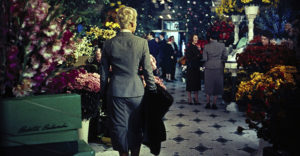Sheila O’Malley on “Bacting” — Acting from the Back
Posted on August 24, 2019 at 8:00 am
Actors often refer to their “instrument,” as though their faces, voices, and bodies are for them what a clarinet or piano or violin is for a musician. The movies invented a new kind of acting, and in its earliest days performers who were expert at projecting to the back row of the theater had to adapt to silent films and close-ups, where the slightest flicker of a facial expression had more of an impact than an entire play’s declaiming.

Kim Novak
Vertigo – 1958
Director: Alfred Hitchcock
Paramount
USA
Scene Still
Sueurs froides
Today we hear their voices, but often in a whisper, and the close-up of a face is still more eloquent than the most compelling line of dialogue. But what if we do not show their face at all? Actress-turned critic/screenwriter/director Sheila O’Malley writes in a fascinating essay for Film Comment about “back-ting,” which she calls what we see, feel, and learn when an actor turns his or her back to the camera.
Movies from the classic Hollywood period are filled with great back-ting, perhaps because so many of the actors came from theater, where the body has to do much of the heavy lifting. If your character is grieving, the people in the cheap seats have to feel it. Watch Joan Crawford walk across a room. She is the container for the film, not the other way around. Crawford, whose closeups remain high watermarks of the art form, understood how her body was responsible for moving the story forward. Maybe the most famous back-ting moment is John Wayne’s in the final shot of The Searchers. Seen through the dark doorway, he turns and walks into the desert. At one point, his left knee buckles underneath him. It’s a subtle stumble. In his lonely back, we can see his terrible awareness of the brutal life he has lived and what it has cost him.
The gold standard of back-ting is Bette Davis. She has yet to be topped. You want to know how a character has transformed? Watch Davis walk across a room. You want to understand a character’s objective? Look at Davis’ posture, or how she lights a cigarette, or where she places her hands. Davis wrote in her first memoir about studying with Martha Graham as a young woman, and how influential dance training was on her approach to performance: “ body via the dance could send a message… would with a single thrust of her weight convey anguish. Then in an anchored lift that made her ten feet tall, she became all joy. One after the other. Hatred, ecstasy, age, compassion! There was no end, once the body was disciplined.” Davis continued: “Every time I climbed a flight of stairs in films—and I spent half my life on them—it was Graham step by step.”
